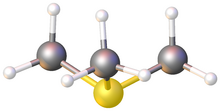Sulfonium

In organic chemistry, a sulfonium ion, also known as sulphonium ion or sulfanium ion, is a positively-charged ion (a "cation") featuring three organic substituents attached to sulfur. These organosulfur compounds have the formula [SR3]+. Together with a negatively-charged counterion, they give sulfonium salts. They are typically colorless solids that are soluble in organic solvent.[2][3]
Synthesis
[edit]Sulfonium compounds are usually synthesized by the reaction of thioethers with alkyl halides. For example, the reaction of dimethyl sulfide with iodomethane yields trimethylsulfonium iodide:
- CH
3–S–CH
3 + CH
3–I → (CH
3)
3S+
I−
The reaction proceeds by a nucleophilic substitution mechanism (SN2) where iodide is the leaving group. The rate of methylation is faster with more electrophilic methylating agents, such as methyl trifluoromethanesulfonate.

Inversion
[edit]Sulfonium ions with three different substituents are chiral owing to their pyramidal structure. Unlike the isoelectronic oxonium ions (R3O+), chiral sulfonium ions are resolvable into optically stable enantiomers.[5] [Me(Et)SCH2CO2H]+ is the first chiral sulfonium cation to be resolved into enantiomers.[6] The barrier to inversion ranges from 100 to 130 kJ/mol.[3]
Applications and occurrence
[edit]Biochemistry
[edit]The sulfonium (more specifically methioninium) species S-adenosylmethionine occurs widely in nature, where it is used as a source of the adenosoyl or methyl radicals. These radicals participate in the biosynthesis of many compounds.[7][8]

Other naturally-occurring sulfonium species are S-methylmethionine (methioninium) and the related dimethylsulfoniopropionate (DMSP).
Organic synthesis
[edit]Sulfonium salts are precursor to sulfur ylides, which are useful in carbon–carbon bond-forming reactions. In a typical application, a R2S+CH2R′ center is deprotonated to give the ylide R2S+CHR−.[9]

Tris(dimethylamino)sulfonium difluorotrimethylsilicate [((CH3)2N)3S]+[F2Si(CH3)3]− is a popular fluoridation agent.[10]
Some azo dyes are modified with sulfonium groups to give them a positive charge. The compound triphenylsulfonium triflate is a photoacid, a compound that under light converts to an acid.[citation needed]
Organic sulfides react with liquid bromine to give bromosulfonium bromides, i.e.:[11]
- RSR′ + [RR′S+Br]Br−
See also
[edit]References
[edit]- ^ Knop, Osvald; Cameron, T. Stanley; Bakshi, Pradip K.; Linden, Antony; Roe, Stephen P. (1994). "Crystal Chemistry of Tetraradial Species. Part 5. Interaction Between Cation Lone Pairs and Phenyl Groups in Tetraphenylborates: Crystal Structures of Me3S+, Et3S+, Me3SO+, Ph2I+, and 1-Azoniapropellane Tetraphenylborates". Canadian Journal of Chemistry. 72 (8): 1870–1881. doi:10.1139/v94-238.
- ^ C. J. M. Stirling, ed. (1981). The Sulphonium Group: Part 1, Volume 1. PATAI'S Chemistry of Functional Groups. John Wiley & Sons. doi:10.1002/9780470771648. ISBN 9780470771648.C. J. M. Stirling, ed. (1981). The Sulphonium Group: Part 2, Volume 2. PATAI'S Chemistry of Functional Groups. John Wiley & Sons. doi:10.1002/9780470771655. ISBN 9780470771655.
- ^ a b Kozhushkov, Sergei I.; Alcarazo, Manuel (2020). "Synthetic Applications of Sulfonium Salts". European Journal of Inorganic Chemistry. 2020 (26): 2486–2500. doi:10.1002/ejic.202000249. PMC 7386937. PMID 32742188.
- ^ DeBose, Jennifer L.; Sean C. Lema; Gabrielle A. Nevitt (2008-03-07). "Dimethylsulfoniopropionate as a foraging cue for reef fishes". Science. 319 (5868): 1356. Bibcode:2008Sci...319.1356D. doi:10.1126/science.1151109. PMID 18323445. S2CID 20782786.
- ^ March, J. "Advanced Organic Chemistry" 5th Ed. J. Wiley and Sons, 1992: New York. ISBN 0-471-60180-2
- ^ Barbachyn, Michael R.; Johnson, Carl R. (1984). "Optical Activation and Utilization of Compounds Containing Chiral Sulfur Centers". Asymmetric Synthesis. pp. 227–261. doi:10.1016/B978-0-12-507704-0.50007-6. ISBN 9780125077040.
- ^ Layer, G.; Heinz, D. W.; Jahn, D.; Schubert, W.-D. "Structure and function of radical SAM enzymes" Current Opinion in Chemical Biology 2004, volume 8, 468-476. doi:10.1016/j.cbpa.2004.08.001
- ^ Perry A. Frey, Olafur Th. Magnusson "S-Adenosylmethionine: A Wolf in Sheep's Clothing, or a Rich Man's Adenosylcobalamin?" Chem. Rev., 2003, 103 (6), pp 2129–2148. doi:10.1021/cr020422m
- ^ Mitchell J. Bogdanowicz, Barry M. Trost (1974). "Cyclopropylphenylsulfonium Tetrafluoroborate". Organic Syntheses. 54: 27. doi:10.15227/orgsyn.054.0027.
- ^ W. J. Middleton (1986). "Tris(dimethylamino)sulfonium difluorotrimethylsilicate". Organic Syntheses. 64: 221. doi:10.15227/orgsyn.064.0221.
- ^ Magee, Philip S. (1971). "The Sulfur–Bromine Bond". In Senning, Alexander (ed.). Sulfur in Organic and Inorganic Chemistry. Vol. 1. New York: Marcel Dekker. pp. 316–321. ISBN 0-8247-1615-9. LCCN 70-154612.
External links
[edit]- IUPAC definition (short pdf)
